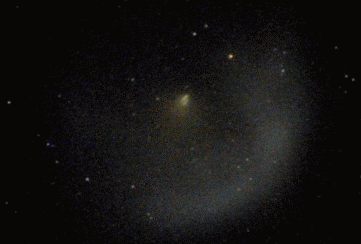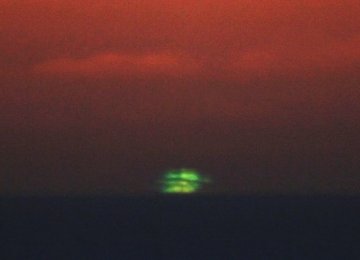 The space shuttle flies in March. Would you like a call when it soars over your backyard? Spaceweather PHONE!
The space shuttle flies in March. Would you like a call when it soars over your backyard? Spaceweather PHONE!
NO SAFE PLACE: The ESA-NASA Ulysses spacecraft has discovered that there is no place in the inner solar system completely safe from solar radiation storms: full story.
DEBRIS SWARM: When a Russian Briz-M rocket booster exploded over Australia on Feb. 19th, astronomer Gordon Garradd was first to report it, and he may have observed the display longer than anyone else--for nearly an hour. That gave him time to take plenty of pictures, which he has stitched together into a remarkable movie. This snippet shows a swarm of fragments expanding around the center of the blast:

Photo details: Nikon D200, 85mm lens @ f/1.6, ISO 500.
The full-length movie contains much more--a billowing cloud of rocket fuel, hundreds of stars, dozens of fragments, and several bright satellites streaking through the field of view. (How many can you count?) Click to view a medium-resolution 4 MB video or a high-resolution 20 MB video.
Experts at NASA and elsewhere are studying these images carefully, both to learn about the physics of satellite break-ups and to track the trajectory of the debris. "There is no immediate threat to the space station," says Mark Matney of NASA's Orbital Debris Office at the Johnson Space Center, "but we're analyzing the orbits to assess any long-term hazard."
TRIPLE GREEN FLASH: "It was the biggest green flash I've ever seen," says Mila Zinkova of San Francisco who took this picture of the setting sun on Dec. 29, 2006:

Click to view the complete sunset sequence
Make that three green flashes: "I think we have here three separate flashes that happened to be visible together," says green flash specialist Andy Young. Ordinary green flashes rely on a mirage to magnify tiny differences in the atmospheric refraction of red and green light. In this case, temperature gradients above the water produced a complex mirage and, not one, but three flashes. "Very interesting!"
There was a time when green flashes were thought to be fables. Jules Verne, of all people, fixed them as real in his 1882 novel "Le Rayon Vert" (The Green Ray). He described "a green which no artist could ever obtain on his palette, a green of which neither the varied tints of vegetation nor the shades of the most limpid sea could ever produce the like! If there is a green in Paradise, it cannot be but of this shade, which most surely is the true green of Hope."
So much eloquence from one green flash. Imagine if he had seen three....

